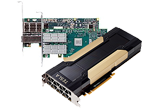ソフトウェア
NAMD
NAMDは米イリノイ大学アーバナ・シャンペーン校のTheoretical and Computational Biophysics Group (TCB)とParallel Programming Laboratory (PPL)との共同研究により開発が進んでいる、無償で入手可能な分子動力学(MD)シミュレーションプログラムです。多くの機能を追加し、数千プロセッサーまでスケーリングされる並列効率の高さで知られ、大規模な系(数百万の原子)のシミュレーションが可能です。プリポストプログラムVMDと連携することでインタラクティブな分子動力学シミュレーションも可能です。
Status
https://www.ks.uiuc.edu/Research/namd/2.13b1/announce.html
September 7, 2018
The Theoretical and Computational Biophysics Group at the University of Illinois is proud to announce the public release of a new version of NAMD, a parallel, object-oriented molecular dynamics code designed for high-performance simulation of large biomolecular systems. NAMD is distributed free of charge and includes source code. NAMD development is supported by the NIH National Institute of General Medical Sciences.
NAMD 2.13b1 has many advantages over NAMD 2.12, including:
– GPU-accelerated simulations less limited by CPU performance
Contributed by Antti-Pekka Hynninen. Bonded forces and exclusions are now offloaded to the GPU by default. (May be disabled with “bondedCUDA 0”. Note that this is a bit flag so default is “bondedCUDA 255”; setting “bondedCUDA 1” will offload only bonds, not angles, dihedrals, etc.) Removes all load-balanced work from the CPU, leaving only integration and optional features. The only benefit is for machines that were limited by CPU performance, so a high-end dual-socket workstation with an older GPU may see no benefit, while a single-socket desktop with the latest 1080 Ti will see the most.
– Improved GPU-accelerated performance for non-orthogonal cells
The “useCUDA2” and “usePMECUDA” kernels introduced in NAMD 2.12 now also support non-orthogonal periodic cells.
– Updated CUDA compatibility to version 9.x
Updated CUDA kernels for version 9.x compatibility, as required by Volta.
– Replica exchange solute tempering, 2nd generation (REST2)
Enhanced sampling method that scales intramolecular potential energy of a protein to lower barriers separating different confirmations. Flexible implementation that allows independent scaling controls over electrostatics, van der Waals, and bonded energy terms. Compatible with CUDA acceleration. Contributed by Wei Jiang and Jonathan Thirman.
– Constant-pH MD
Makes use of nonequilibrium MD / Monte Carlo moves to enable constant-pH MD simulation of explicit solvent systems, with computational cost that increases linearly with the number of titratable groups. Contributed by Brian Radak.
– Improvements to hybrid QM/MM simulation
Combine QM calculations for regions such as active sites of enzymes with fast classical calculation for the rest of the biomolecular system. Interfaces provided to QM packages MOPAC and ORCA. Improvements since 2.12 include simulation setup with QwikMD and visualization of molecular orbitals using VMD, plus various bug fixes to NAMD. Contributed by Marcelo Melo, Rafael Bernardi, and Till Rudack.
– Stochastic velocity rescaling thermostat
Thermostat due to Bussi, Donadio, and Parrinello. The method preserves holonomic constraints, so is less disruptive to dynamics than Langevin damping, while maintaining compatiblity with NAMD’s constant pressure barostat. Less CPU calculation is required, which can result in up to 20% performance improvement for CUDA-accelerated runs employing modern GPUs. Contributed by Brian Radak.
– Gaussian accelerated MD (GaMD)
Contributed by Andrew Pang and Yi Wang.
– Updated version of random acceleration MD (RAMD)
The t-random acceleration molecular dynamics (tRAMD) is a protocol for the ranking of drug candidates by their residence time and obtaining insights into ligand-target dissociation mechanism (https://www.h-its.org/downloads/ramd/). Contributed by Stefan Richter and Rebecca Wade.
– Improved lonepair support
Include support for colinear lonepairs. Improve CHARMM force field compatibility by automatically detecting lonepair section of PSF, plus various bug fixes.
– Interleaved double-wide sampling for FEP
Contributed by Jerome Henin.
– Extend nonbondedScaling to LJ correction term
Contributed by Brian Radak.
– Collective variables module improvements
Contributed by Giacomo Fiorin and Jerome Henin.
– IMDignoreForces option for QwikMD
Blocks steering forces while still allowing pause/resume/exit commands.
– Various psfgen improvements
When reading topology files, recognize READ statements even if previous END statement is missing, and warn and ignore on self and duplicate bonds. For topology file PRES (patch) entries support ATOM record with name but no type or charge to specify subsequent atom insertion order. Extend segment command to query charge.
– Support for billion-atom systems
Fixed 32-bit integer overflows in psfgen, structure compression (takes 2 hours), and memopt build. Minimally tested on 10x10x10 grid of STMV with ldBalancer none.
– Update to Charm++ 6.8.2
Various bug fixes and performance enhancements.
– Require CUDA 8.0 or greater, Kepler or newer GPUs
Includes kernels compiled for Kepler, Maxwell, Pascal, and Volta GPUs. Support for Fermi GPUs was dropped in NAMD 2.12.
マニュアル
http://www.ks.uiuc.edu/Research/namd/
特記事項
開発ツールが、charm+という特殊ソフトで、これも大規模クラスタ向けソフトです。VMDをプリポスとして使用するので、これが必須です。ソースは無料で入手出来ますが、配付元でアカウント登録が必要です。
お問い合わせ
平日9:30~17:30 (土曜日、日曜日、祝祭日、年末年始、夏期休暇は、休日とさせていただきます。)








